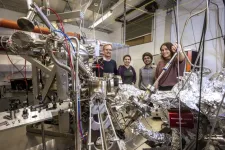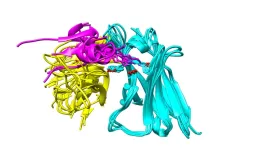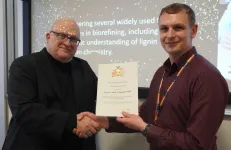(Press-News.org) An implant that delivers electrical stimulation to a select group of spinal neurons can treat dangerously low blood pressure in people with spinal cord injuries, addressing an often “invisible” consequence of paralysis.
For his work in developing this treatment, called the neuroprosthetic baroreflex, Jordan W. Squair is the winner of the 2023 BioInnovation Institute & Science Prize for Innovation. The prize seeks to reward scientists who deliver research at the intersection of the life sciences and entrepreneurship.
“Dr. Squair’s prize-winning research on epidural electrical stimulation restores blood pressure control in patients suffering from spinal cord injury,” said Yevgeniya Nusinovich, senior editor at Science. “Using this technology to stabilize blood pressure in the normal range decreases patients’ risk of fainting and other complications, greatly improving their safety and quality of life.”
Squair, a researcher with NeuroRestore at the Swiss Federal Institute of Technology (EPFL), said the treatment offers a new way to address a problem that affects up to 90% of people with spinal cord injuries.
In addition to spinal cord injury, a woman with severe motor and autonomic nervous system disease, who had such low blood pressure that she could not stand for more than a few minutes at a time, was able to walk several hundred meters immediately after receiving the implant and has stopped fainting, Squair wrote in his prize-winning essay in Science.
“Since then it’s been a really cool experience to see it work every single time in every person that we’ve tested,” he said. “It’s exciting to see a functional neurosurgical approach that works that robustly and that simply.”
Spinal cord injury can prevent the brain from modulating blood pressure during posture changes, such as moving to a sitting or standing position. A person’s blood pressure can drop to very low levels as a result, which may keep them bedridden, dizzy, nauseous, or prone to fainting.
“Almost all of these patients are being treated for orthostatic hypotension using conservative measures like an abdominal binder, maybe compression stockings on their legs, or they’ve been recommended to have a high salt diet, things like that,” Squair said. “But if you then ask them if they still experience symptoms of it, despite being treated conservatively for it, they almost all still do.”
Squair and his colleagues at EPFL and the University of Calgary developed a way to treat this lesser-known consequence of spinal cord injury by expanding the use of epidural electrical stimulation (EES), which has been used in some people to restore movement and sensation.
Neuroscientists Grégoire Courtine and Jocelyne Bloch, who lead NeuroRestore, showed “that if you stimulate a certain part of the spinal cord, you can activate the expected function,” Squair said.
Finding the right part of the spinal cord to stimulate was one of the essential first steps in developing the new treatment. Squair systematically tested the spinal cord segment by segment in rodents, combining these findings with anatomical studies. He found that “the best place to stimulate coincides with the place in the spinal cord that contains the most neurons that are relevant for controlling blood pressure.”
The last three thoracic segments of the spine are enriched in these neurons. These “hotspots” can be found in mice, rats, pigs, and non-human primates, and have been mapped in some humans, “and they seem to hold up across species,” said Squair.
This work is now supported by a large consortium funded by the U.S. Defense Advanced Research Projects Agency (DARPA), to expand the treatment’s capabilities. For instance, the implant might be useful in the acute phase of spinal cord injury, when blood pressure can be unstable.
At the moment, this problem is treated with drugs that can overshoot their therapeutic mark or wear off, “so there might be a role for this [implant] to keep people stable when they’re in the ICU or spine unit,” Squair explained.
Inside the hospital, blood pressure changes are monitored carefully with an invasive arterial line. But when a patient leaves the hospital, “there’s not really any way that anyone currently has to monitor blood pressure with that kind of resolution,” he said. “So part of the DARPA program is to try to advance that capability, to potentially monitor blood pressure with every beat of the heart.”
Clinical trials in collaboration with ONWARD Medical of the implant could begin by next year, Squair said.
“This year’s finalists have conducted some truly exceptional research and the standard of all entries was extremely high,” said Jens Nielsen, chief executive officer at BioInnovation Institute. “Their work combines cutting edge science with entrepreneurial spirit, aligning with BII’s goals of improving human and planetary health.”
FINALISTS
Samuel Bakhoum is a 2023 finalist for his essay “Targeting the undruggable.” Bakhoum received undergraduate degrees from Simon Fraser University, his Ph.D. from Dartmouth College, and his M.D. degree from Geisel School of Medicine at Dartmouth. After completing his clinical training at Memorial Sloan Kettering Cancer Center (MSKCC) and a postdoctoral fellowship at Weill Cornell Medicine, he started his laboratory in the Human Oncology and Pathogenesis Program and the department of radiation oncology at MSKCC in 2018. His research aims to understand the cellular mechanisms by which chromosomal instability drives cancer progression.
Kaira Wagoner is a 2023 finalist for her essay “Helping honeybees help themselves.” Wagoner received an undergraduate degree from Guilford College and her master’s and Ph.D. degrees from the University of North Carolina Greensboro. After completing her postdoctoral fellowship at UNC Greensboro, Kaira started her laboratory in its biology department in 2021. Her research focuses on insect chemical communication, pollinator behavioral ecology, and honeybee pests and diseases.
END
Implant treats dangerously low blood pressure in people with spinal cord injury
2023-04-06
ELSE PRESS RELEASES FROM THIS DATE:
Editorial: Share SARS-CoV-2 data immediately
2023-04-06
In an editorial, Maria Van Kerkhove – who serves as the technical lead for the COVID-19 response at the World Health Organization (WHO) – outlines how earlier this month (March 2023), WHO learned that scientists in China possessed data on viral samples from Wuhan that had been gathered in January 2020. “These should have been shared immediately—not 3 years later,” she writes. “The lack of data disclosure is simply inexcusable.” WHO continues to call on China and all countries to share any data on the origins of SARS-CoV-2 immediately. “China has advanced technical capabilities,” Van ...
Uncovered: A new mode of reproduction that produces chimeric males in yellow crazy ants
2023-04-06
Male yellow crazy ants (Anoplolepis gracilipes) are chimeras of two separate genetic lineages, researchers report in a study that reveals a unique mode of reproduction in this species – one previously unknown to science. While most multicellular organisms develop from a single-cell zygote into a collection of genetically identical cells – a hallmark of biological inheritance – the new findings show that yellow crazy ants deviate from this expectation. According to the study, all male yellow crazy ants are instead composed ...
Bushmeat consumption unchanged by COVID-19 in Kenya and Tanzania border towns, new study reveals
2023-04-06
First ever study looking at disease risks of wild meat activities in rural communities.
Nearly 70% of rural respondents at Kenya-Tanzania border said that COVID-19 did not impact their levels of wild meat consumption, with some even reporting increased consumption.
Ungulates were found to be the most consumed species, followed by birds, rodents and shrews.
Governments need to focus on better controlling zoonotic disease transmission risks through community engagements on behavior change interventions, improving hygiene and standards of informal markets, supporting wildlife conservation ...
Methyl groups enhance key properties of PHA plastics and enable closed-loop recyclability
2023-04-06
A class of polyesters considered a promising alternative to common plastics, were it not for limitations like brittleness and thermal instability, have now been made more mechanically tough and thermally stable. Researchers replaced the reactive hydrogens in the monomer of these materials – polyhydroxyalkanoate (PHA) plastics – and found it enhanced PHA thermal and mechanical properties and enabled closed-loop chemical recyclability. The new approach could provide a route for increased use of sustainable PHA plastics. ...
Ultra-fast light at the end of the vacuum tunnel: Meta-optics shows physical processes in the attosecond range
2023-04-06
Developed at Harvard, and successfully tested at Graz University of Technology (TU Graz), a revolutionary new meta-optics for microscopes with extremely high spatial and temporal resolution has proven its functional ability in laboratory tests at the Institute of Experimental Physics at TU Graz. Microscopes using this kind of lens promise completely new research and development approaches, especially in semiconductor and solar cell technology. The research team from Graz and Boston currently reports on the construction and the successful laboratory experiment with this new meta-optics in the specialist journal Science.
The lens of ...
New atomic-scale understanding of catalysis could unlock massive energy savings
2023-04-06
MADISON – In an advance they consider a breakthrough in computational chemistry research, University of Wisconsin–Madison chemical engineers have developed model of how catalytic reactions work at the atomic scale. This understanding could allow engineers and chemists to develop more efficient catalysts and tune industrial processes — potentially with enormous energy savings, given that 90% of the products we encounter in our lives are produced, at least partially, via catalysis.
Catalyst materials accelerate chemical reactions without undergoing changes themselves. ...
Researchers reveal why viruses like SARS-CoV-2 can reinfect hosts, evade the immune response
2023-04-06
The human body is capable of creating a vast, diverse repertoire of antibodies—the Y-shaped sniffer dogs of the immune system that can find and flag foreign invaders. Despite our ability to create a range of antibodies to target viruses, humans create antibodies that target the same viral regions again and again, according to a new study led by investigators from Brigham and Women’s Hospital, a founding member of the Mass General Brigham healthcare system, and Harvard Medical School. These “public epitopes” mean that the generation ...
UH study finds Black Lives Matter movement had significant impact on Black entrepreneurs’ crowdfunding efforts
2023-04-06
New research conducted by the University of Houston Conrad N. Hilton College of Global Hospitality Leadership suggests the Black Lives Matter movement had a significant, positive impact on the fundraising efforts of Black restaurateurs.
In a study published in the International Journal of Hospitality Management, the researchers found in the decade before Black Lives Matter rose to prominence, Black restaurateurs were 76% less likely to be successful in the use of crowdfunding sources, such as Kickstarter, than non-Black restaurateurs. From 2010 – 2015, funding was 72% lower for Black-owned businesses and from 2016-2020 it was 79% lower.
But that all changed ...
Aston University hosts Royal Society of Chemistry prize-giving
2023-04-06
Professor Arthur Ragauskas awarded Royal Society of Chemistry prize
He is based at the Oak Ridge National Laboratory and University of Tennessee
He chose to receive award at Aston University because of its research into renewable resources.
Aston University has hosted a prestigious Royal Society of Chemistry prize-giving and lecture.
Professor Arthur Ragauskas of the Oak Ridge National Laboratory and University of Tennessee chose the University as the venue for this event because its research into renewable resources has inspired his work.
He is the recipient of the Society’s 2022 environment, sustainability and energy division open award: Environment ...
New professor to boost Aston University’s photonics expertise
2023-04-06
Professor Richard Hogg will be joining Aston Institute of Photonics Technologies
It is a leading photonics research centre, with a successful track record of scientific achievements
Professor Hogg will be focusing on research and commercialisation.
Aston University is to welcome Professor Richard Hogg who will be joining its flagship photonics research institute
He will be focusing on research and commercialisation at Aston Institute for Photonic Technologies, Aston University’s Aston Institute of Photonics Technologies (AIPT) a leading photonics research institute with a successful track record of ...




